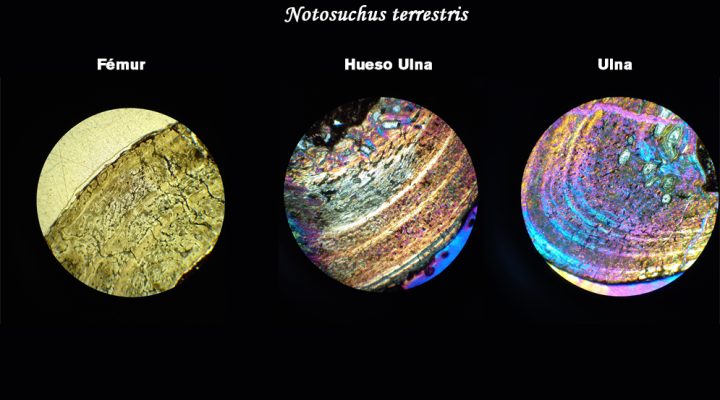EXACT AND NATURAL SCIENCES
Scientists reveal the growth dynamics of a relative of today’s crocodiles that lived 85 million years ago in Patagonia
A research team analyzed the internal structure of the bones of numerous specimens of the species Notosuchus terrestris.
CONICET researchers described the dynamics of growth, maturation and intraspecific and intraskeletal variation of Notosuchus terrestris, a reptile that inhabited northern Argentine Patagonia about 85 million years ago, during the Upper Cretaceous. This species, belonging to a group of terrestrial crocodyliformes known as notosuchians (Notosuchia), was discovered for the first time in 1896 in the Bajo de la Carpa Formation in the Province of Neuquén. The study was recently published in the journal Cretaceous Research.
“This study has one of the largest paleo histological samples on the Notosuchia clade. With the aim of inferring paleobiological aspects of Notosuchus, a characterization of the microanatomy of different bones was carried out. Among them, the humerus, ulna, radius and femur of six individuals were analyzed. From thin sections made, the experts concluded that Notosuchus terrestris presents a compact bone made up mainly of interwoven bone, which shows moments of rapid growth. In addition, cyclical growth marks indicate periods of decreased growth and even moments of growth cessation. All this shows that the growth process of Notosuchus terrestris was different from that of other members of the Notosuchia group and from that of modern crocodiles. Regarding sexual maturity, the moment in which the sexual organs reach their full development and somatic maturity, when body growth stops, it was observed that it is prior to the complete maturation of the skeleton,” comments Tamara Navarro, CONICET doctoral fellow at the Instituto de Investigación en Paleobiología y Geología (IIPG, CONICET-UNRN) and first author of the study.
The researcher explains that the material arrived at the Carlos Ameghino Museum in Cipolletti (Río Negro) and from there a record of its dimensions was made, it was photographed and a cross section of one centimeter in diameter was extracted from the center of the diaphysis of the bone to make a replica of it. “Once the material regained its original appearance and measurements, I prepared the thin cuts. To do this, the bone is placed in a mold and filled with an acrylic resin, forming a tablet to prevent the material from being damaged by subsequent polishing processes. Then this pellet is mounted on a slide to continue polishing until it is thin and the microstructural characteristics of the bone can be observed. From this process we proceed to its description and subsequent biological conclusions,” says the scientist.
“In the future it would be interesting to explore the dental histology and dental anchorage of Notosuchia since from them it is possible to infer dietary issues, dental replacement rates and other poorly explored issues. On the other hand, the analysis of the histology of the appendicular bones would allow us to further expand the general knowledge of the paleobiology of the aforementioned group and contribute to answering macroevolutionary questions regarding the ecophysiology of tetrapods or how the Cretaceous/Paleogene extinction affected the fauna. of vertebrates,” explains Navarro.
Ignacio Cerda and Diego Pol, CONICET researchers at the IIPG and at the Museo Paleontológico Egidio Feruglio (Trelew, Chubut), respectively, also participated in the study.
References:
Navarro, T. G., Cerda, I. A., & Pol, D. (2023). Microstructural characterization and growth dynamics in Notosuchus terrestris, a Mesoeucrocodylia crocodyliform from the Upper Cretaceous of Northern Patagonia, Argentina. Cretaceous Research, 150, 105607. DOI: https://www.science
By Nahuel Aldir – Área de Comunicación del Instituto de Investigación en Paleobiología y Geología (IIPG, CONICET-UNRN)
